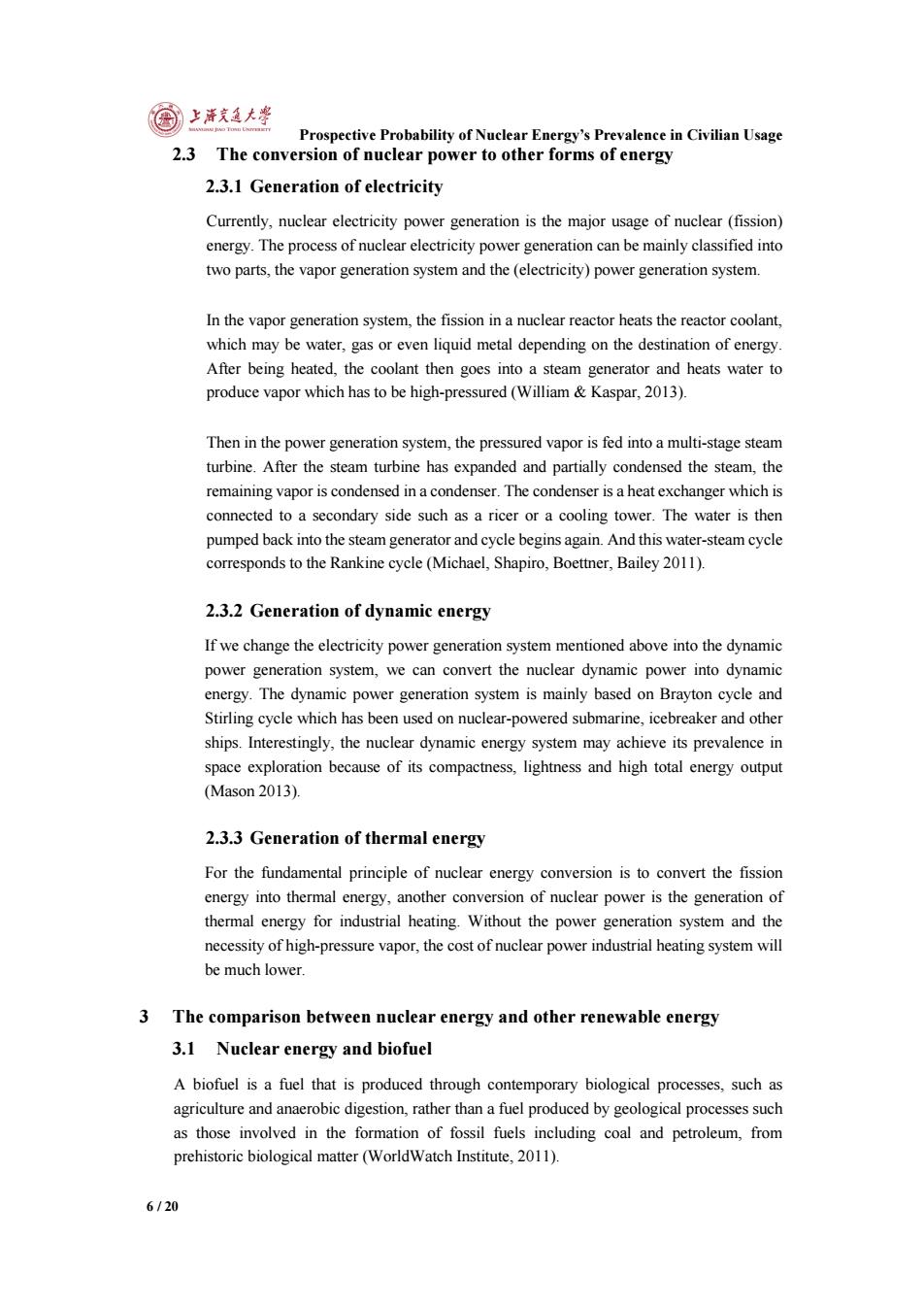正在加载图片...

国上道大》 Prospective Probability of Nuclear Energy's Prevalence in Civilian Usage 2.3 The conversion of nuclear power to other forms of energy 2.3.1 Generation of electricity Currently,nuclear electricity power generation is the major usage of nuclear(fission) energy.The process of nuclear electricity power generation can be mainly classified into two parts,the vapor generation system and the(electricity)power generation system. In the vapor generation system,the fission in a nuclear reactor heats the reactor coolant, which may be water,gas or even liquid metal depending on the destination of energy. After being heated,the coolant then goes into a steam generator and heats water to produce vapor which has to be high-pressured (William Kaspar,2013). Then in the power generation system,the pressured vapor is fed into a multi-stage steam turbine.After the steam turbine has expanded and partially condensed the steam,the remaining vapor is condensed in a condenser.The condenser is a heat exchanger which is connected to a secondary side such as a ricer or a cooling tower.The water is then pumped back into the steam generator and cycle begins again.And this water-steam cycle corresponds to the Rankine cycle(Michael,Shapiro,Boettner,Bailey 2011). 2.3.2 Generation of dynamic energy If we change the electricity power generation system mentioned above into the dynamic power generation system,we can convert the nuclear dynamic power into dynamic energy.The dynamic power generation system is mainly based on Brayton cycle and Stirling cycle which has been used on nuclear-powered submarine,icebreaker and other ships.Interestingly,the nuclear dynamic energy system may achieve its prevalence in space exploration because of its compactness,lightness and high total energy output (Mason 2013). 2.3.3 Generation of thermal energy For the fundamental principle of nuclear energy conversion is to convert the fission energy into thermal energy,another conversion of nuclear power is the generation of thermal energy for industrial heating.Without the power generation system and the necessity of high-pressure vapor,the cost of nuclear power industrial heating system will be much lower. 3 The comparison between nuclear energy and other renewable energy 3.1 Nuclear energy and biofuel A biofuel is a fuel that is produced through contemporary biological processes,such as agriculture and anaerobic digestion,rather than a fuel produced by geological processes such as those involved in the formation of fossil fuels including coal and petroleum,from prehistoric biological matter (WorldWatch Institute.2011). 6/20Prospective Probability of Nuclear Energy’s Prevalence in Civilian Usage 6 / 20 2.3 The conversion of nuclear power to other forms of energy 2.3.1 Generation of electricity Currently, nuclear electricity power generation is the major usage of nuclear (fission) energy. The process of nuclear electricity power generation can be mainly classified into two parts, the vapor generation system and the (electricity) power generation system. In the vapor generation system, the fission in a nuclear reactor heats the reactor coolant, which may be water, gas or even liquid metal depending on the destination of energy. After being heated, the coolant then goes into a steam generator and heats water to produce vapor which has to be high-pressured (William & Kaspar, 2013). Then in the power generation system, the pressured vapor is fed into a multi-stage steam turbine. After the steam turbine has expanded and partially condensed the steam, the remaining vapor is condensed in a condenser. The condenser is a heat exchanger which is connected to a secondary side such as a ricer or a cooling tower. The water is then pumped back into the steam generator and cycle begins again. And this water-steam cycle corresponds to the Rankine cycle (Michael, Shapiro, Boettner, Bailey 2011). 2.3.2 Generation of dynamic energy If we change the electricity power generation system mentioned above into the dynamic power generation system, we can convert the nuclear dynamic power into dynamic energy. The dynamic power generation system is mainly based on Brayton cycle and Stirling cycle which has been used on nuclear-powered submarine, icebreaker and other ships. Interestingly, the nuclear dynamic energy system may achieve its prevalence in space exploration because of its compactness, lightness and high total energy output (Mason 2013). 2.3.3 Generation of thermal energy For the fundamental principle of nuclear energy conversion is to convert the fission energy into thermal energy, another conversion of nuclear power is the generation of thermal energy for industrial heating. Without the power generation system and the necessity of high-pressure vapor, the cost of nuclear power industrial heating system will be much lower. 3 The comparison between nuclear energy and other renewable energy 3.1 Nuclear energy and biofuel A biofuel is a fuel that is produced through contemporary biological processes, such as agriculture and anaerobic digestion, rather than a fuel produced by geological processes such as those involved in the formation of fossil fuels including coal and petroleum, from prehistoric biological matter (WorldWatch Institute, 2011)